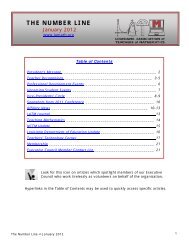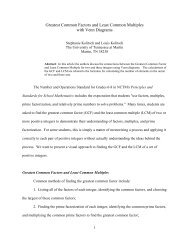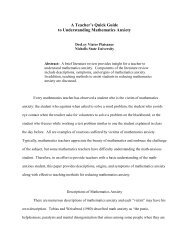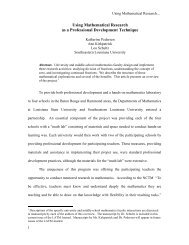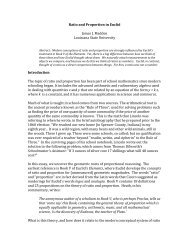Assessment of Students' Learning in Plane & Solid Geometry ...
Assessment of Students' Learning in Plane & Solid Geometry ...
Assessment of Students' Learning in Plane & Solid Geometry ...
You also want an ePaper? Increase the reach of your titles
YUMPU automatically turns print PDFs into web optimized ePapers that Google loves.
Regardless <strong>of</strong> the assessment technique used, geometry from the hands-on perspective is amust. The hands-on perspective supports the use <strong>of</strong> demonstrations and performance tasks as ameans <strong>of</strong> collect<strong>in</strong>g assessment data. Students can demonstrate such th<strong>in</strong>gs as the proper use <strong>of</strong>learn<strong>in</strong>g tools and manipulatives. For example, some students may be adept at paper fold<strong>in</strong>g(origami) and will be able to demonstrate how to make various shapes and solids.There are many performance tasks that can be implemented to guide students <strong>in</strong> apply<strong>in</strong>g avariety <strong>of</strong> concepts and skills. One task is to request students to build a solid us<strong>in</strong>g everyday objectssuch as straws, pipe cleaners, lollypop or Popsicle sticks, <strong>in</strong>dex cards, str<strong>in</strong>g, pencils, etc. Studentscan display their productions on mobiles <strong>in</strong> the classroom and engage <strong>in</strong> discussions about thevariations <strong>of</strong> the objects. They can also test characteristics, such as strength, <strong>of</strong> the model solids.Another useful performance task is to <strong>in</strong>struct students on how to build scaled models <strong>of</strong>objects or build<strong>in</strong>gs (e.g., the United States’ Pentagon, the Egyptian pyramid at Giza, etc.). By us<strong>in</strong>ga scale like one <strong>in</strong>ch represents 100 feet (or whatever is most appropriate). A performance task suchas this encompasses pla<strong>in</strong> and solid geometry, measurement, number sense, visualization, wholenumbers, and fractions. In addition, a build<strong>in</strong>g project such as this can <strong>in</strong>tegrate mathematics withother subjects such as social studies and history.On the day(s) for demonstrations and performances, students can set up their own stations.One-half <strong>of</strong> the class plays the role <strong>of</strong> audience for the first part <strong>of</strong> the <strong>in</strong>struction time and one-half<strong>of</strong> the class plays the role <strong>of</strong> demonstrators/performers. This is reversed for the second part <strong>of</strong> the<strong>in</strong>struction time. Small groups <strong>of</strong> students and the teacher can rotate from station to station view<strong>in</strong>gand observ<strong>in</strong>g the demonstrators/performers at work. Each demonstrator/performer might also havea visual display (e.g., poster) <strong>in</strong>form<strong>in</strong>g the audience <strong>of</strong> the subject and expectations <strong>of</strong> the project.Students <strong>in</strong> the audience can ask questions and make comments to the demonstrator/performer. Theteacher might also choose to photograph the students at work and <strong>in</strong>clude this and other records <strong>of</strong> thetask <strong>in</strong> the students’ portfolio for further assessment. After all <strong>of</strong> the demonstrations and



